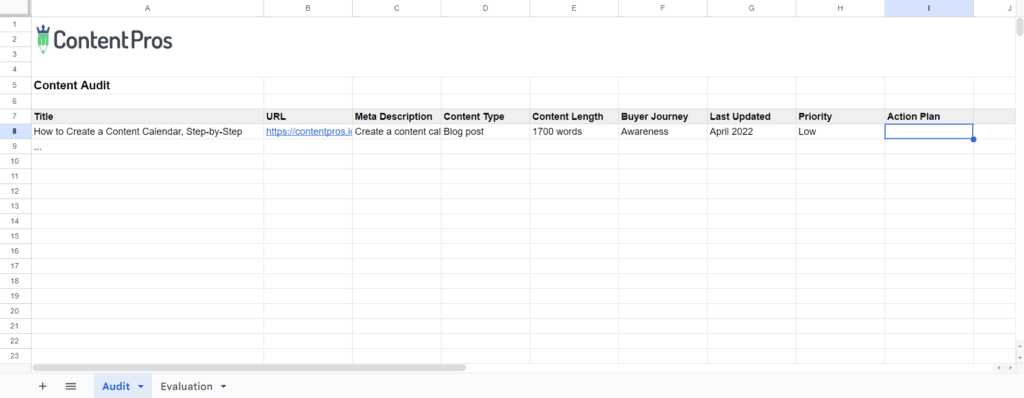Today, six million content marketers will publish a new blog post. And tomorrow, we’ll see a wave of six million more. While you’re not producing quite as much content yourself, it’s worthwhile to step back and do a content audit to see what you’ve created and where to go next.
It’s no secret that content marketing has exploded. We’re creating content at a faster pace than our audiences can consume it. So there’s a good chance you’re sitting on a mountain of content without fully utilizing it—that’s where a content audit comes in.
Here’s why a content audit is a worthwhile effort and how to do an audit from start to finish.
What Is a Content Audit?
We define content audit as the intentional process of reviewing your existing content. It includes:
- Blog articles
- Images
- Infographics
- Website pages
- Landing pages
- Lead magnets
- Content upgrades
- Videos
- Podcasts
- Title tags and meta descriptions
- Downloadable or gated assets
- Product descriptions
- PDFs
- Quizzes or other interactive content
The goal of a content audit is to understand what content you have and decide which assets you might create next. It also provides an opportunity to improve existing assets to ensure alignment with your brand and content strategy.
Content Audit vs. Content Evaluation
Content audits share similarities to content evaluations. Think of audits as the precursor to evaluations. Audits are like taking inventory of your content assets, while evaluations serve to track content performance.
Auditing your content helps you organize your assets and ensure your content meets basic quality standards. Doing this groundwork first will make your content evaluations more streamlined and impactful.
How to Do a Content Audit
Here are the steps and tools you’ll need to conduct an effective audit:
1. Prepare for Your Content Audit
Before you dive into the nuts and bolts of auditing content, you need clear direction on what you’re doing and why you’re doing it. Take a moment to address the following:
Define Your Goals
Be specific about what you want to get out of your content audit. It’s a great opportunity to check for the following:
- Content follows your brand voice guidelines
- Content quality is consistent with your brand
- Each piece is optimized for search engines
- Remove or refresh outdated content
- Content encourages conversions
- Gaps that can be filled with new content
- The content is better than your competitors’ content on the same topic
Gather Resources
Content audits require many moving parts and can be a time consuming process. Decide who will conduct the audit and ensure they have access to relevant data and tools.
Using content auditing tools can help you spot opportunities to make your content relevant and properly optimized. Examples of free tools include:
- On-page SEO tools to identify pages and target keywords
- Site audit tools, like Google Search Console, to find broken links and suggest improvements
- Google Sheets to organize your findings
- Google Analytics to identify individual pages
- Hemingway App to check for readability
- Grammarly to find misspellings, grammatical errors, and other quality issues
2. Take a Content Inventory
Content audits can get deep and intricate—quickly. To make the process more manageable, take inventory of all of your content assets and organize them by category.
For quick audits: Narrow your focus to one asset category (e.g., blog posts, images, white papers).
For detailed audits: Compile a thorough list of assets and organize them by content format, publication date, and topic.
For either type of audit, it’s helpful to collect additional data, such as URLs, word count, author, and keywords. You can organize this data in a content audit spreadsheet for easier cross-referencing.

©AndreyPopov via Canva.com
3. Audit Your Content
Now for the heavy lifting—start auditing your content against your success metrics, piece by piece. This process largely depends on your goals—let’s look at some examples.
For Search Engine Optimization
If you are auditing your content for SEO, use an SEO checklist to find areas for improvement. It might look like this:
- Keyword in URL
- Keyword in title
- Meta description with keyword
- Keyword in the introduction, conclusion, and at least one header
- Content organized by H2s and H3s
- Images and visual interest
- Alt text for images
- Internal and external links
- Inbound links
- No broken links
- Call-to-action
- Page is getting organic search traffic
- Content is up to date
- Additional focus words appear throughout the page
- Free of grammar and spelling errors
For Content Improvements
You’ve already put hours into creating your content. Updating or repurposing existing content helps you stretch your investment even further. Some areas of interest might include:
- Updating stats and facts
- Changing images
- Adding more visual interest (e.g., images, videos, infographics)
- Making the content more skimmable
- Turning long sections into standalone blog posts, videos, or other content formats
- Pulling quotes or insights for social media posts
- Checking for broken links
- Including more internal links
For Branding
If you’re auditing content for brand voice alignment, you might have your own list of things each blog post should include.
If the tone or style feels off, consider hiring a professional content writer who can rewrite the piece in your desired style. This can be more cost-effective than starting from scratch.
For Conversions
Whether you want readers to sign up for a newsletter or make a purchase on the spot, your content needs to be written in a way that encourages those actions. Auditing your content for conversions can significantly improve your outcomes. Look for the following signs:
- Clear calls-to-action
- One goal per piece of content
- Content aligns with the stage of the buyer journey
- Content aligns with search intent
- Minimal distractions on the page
- Social proof or other trust factors
- Minimal friction to convert readers
For Competitive Benchmarking
If your competition is stealing your topic ideas, it’s wise to do a side-by-side comparison to see how you stack up. Areas that might impact performance include:
- Content length
- Writing quality
- Content depth
- Backlinks
- Publication date
- Number of keywords
- Usability and format
- Quality of links and information sources
Establishing these criteria first will help you move quickly through your audit and know exactly what you’re looking for.
Pro Tip: Record this information in your content audit spreadsheet to keep all your findings in one place.
4. Identify Content Gaps
Content audits aren’t just about taking inventory and meeting basic requirements. They also provide a bird’s eye view of your content assets so you can decide what else your content calendar needs. Here are some ways to do this:
- Search for topics you haven’t covered yet
- Discover what your competitors are talking about
- Track community discussion groups to see what your audience is talking about
- Use Answer the Public to find questions your customers are asking
- Use keyword tools like UberSuggest to find new keyword opportunities
- Read top-ranking articles on a topic to learn what they’re missing
Successful content marketing means focusing on the positive space and the negative space—what’s being said and what’s not yet discussed.

5. Develop a Content Action Plan
Knowing what you know now, you can start choosing content to repurpose, update, or nix altogether. You can also decide what new content you need to create to keep building on your successes.
- Create: Content on new topics you haven’t yet covered and have strong organic search potential.
- Keep: Content that’s evergreen and performing well.
- Repurpose: Content that’s performing well and can translate into other formats (e.g., turn a blog post into a YouTube video)
- Update: Content that’s underperforming and/or outdated but is still relevant to your business and audience.
- Toss: Content you can’t improve or is no longer relevant to your business or audience.
Assign action steps to each piece of content so you can start making improvements right away. Completing a content audit doesn’t happen in a day, so documenting your next best actions will let you pick up where you leave off.
Free Content Audit Template
Using a content audit template removes much of the guesswork. We created a free content audit template to help you capture important data points—use it to help you develop your content calendar.

Get Expert Help with Content Creation and Strategy
When you finish your content audit, you’ll have plenty of priorities to juggle. Outsourcing some of these tasks to a content writing and editing team can help you start reaping the full value of your updated, newly optimized content.
Content Pros is happy to update and repurpose your existing content to make it the best it can be. Contact us today to get started.

